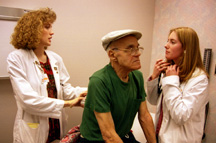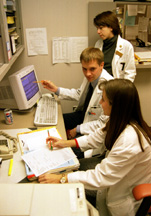 Purdue News
Purdue News
 Purdue News
Purdue News

|
|
1998
Universities change prescriptions
WEST LAFAYETTE, Ind. -- As the job description for pharmacists has expanded, more,
too, is being required of pharmacy students. |

|
Purdue's School of Pharmacy and Pharmacal Sciences is modifying its curriculum to make the doctor of pharmacy -- or Pharm. D. program -- the entry-level preparation for practice.
Starting in the fall of 1999, students entering the school as freshmen will automatically be enrolled in the six-year program that includes 44 weeks of practical experience in professional settings, such as pharmacies, clinics, long-term care settings and hospitals. The conversion will phase out the existing four-year bachelor of science degree in pharmacy.
Pharmacy schools nationwide are following suit, and a few schools already have new programs in place, says Charles Rutledge, dean of the School of Pharmacy and Pharmacal Sciences and immediate past president of the American Association of Colleges of Pharmacy.
"To deliver pharmaceutical care, it is not enough just to be knowledgeable about medications and drug therapy," Rutledge says. "Today's pharmacist also must be able to work with physicians, patients and interdisciplinary health-care teams to address the individual needs of patients and to ensure that patients get the most out of their drug therapy."
Among the trends in health care that are fueling the need for a change in the way students prepare for the workplace:
In addition, concerns about ever-growing health-care costs have forged a new working relationship between pharmacists and physicians, with pharmacists taking a much more active role in monitoring the outcomes and cost-effectiveness of drug use, Rutledge says.
An integral part of the changes in the Purdue program is the introduction of courses that emphasize skills such as oral and written communications, decision-making and group interaction.
"Traditional education in pharmacy schools has been 'teacher-centered' with emphasis on lectures and exams to ensure the students are grounded in knowledge," says Robert Chalmers, associate dean for professional programs in Purdue's pharmacy school. "Education for today's pharmacist requires our courses to incorporate 'learner-centered' approaches in which students are actively engaged in developing a number of these intellectual, social and clinical abilities."
Purdue has offered a Pharm. D. program since 1976.
During the first decade, a small number of students took advantage of the program. Over the past 10 years, however, the program has grown significantly as students recognized the benefits of carrying advanced skills into the workplace, Chalmers says.
"The Pharm. D. program offers a more focused and mentored kind of education and training," he says. "For students, this translates into opportunities to work side-by-side with instructors and other professionals in pharmacies, clinics and hospitals."
There, students get first-hand experience in working with patients and collaborating with other health professionals to make specific recommendations for pharmaceutical therapy.
For example, Deanna Kania, assistant professor in the Department of Pharmacy Practice who specializes in drug therapy for patients being treated with anticoagulation drugs, or blood-thinners, uses a clinic at the Roudebush V.A. Medical Center in Indianapolis to teach pharmacy students how to monitor such drugs in patients.
"Because these drugs have a very narrow therapeutic range, they must be monitored carefully," she says. "Patients with too much of the drug in their bloodstream may develop problems with bleeding, while patients with too little may not get any therapeutic effect."
She says physicians often call her and her students to tap their expertise on how to establish the optimal dosages for a variety drugs.
"We also take a proactive approach and call physicians if we see patients who need adjustments in any of their dosages," she says.
Learning in a structured environment such as a hospital provides students with practical knowledge they can take with them when they graduate, Kania says: "Pharmacy practice is changing, and students must be able to juggle many roles and interact with both patients and physicians."

|
"Health care has changed over the past few years, and the role of the pharmacist has expanded," Landis says. "A lot of patients are seeing multiple physicians, and they depend upon the pharmacist to intervene and help them prevent, identify or resolve problems with their medications."
The most challenging part for many students is actually developing relationships with the patients, Landis says: "Communication skills and the so-called 'bedside-manner' are something you can only develop through experience and patient contact."
Sources: Charles Rutledge, (765) 494-1368; e-mail, chipr@pharmacy.purdue.edu
Robert Chalmers, (765) 494-1382; e-mail, chalmers@pharmacy.purdue.edu
Deanna Kania, (317) 630-7093; e-mail, kania.deanna_s@indianapolis.va.gov
Winnie Landis, (765) 448-1615
Writer: Susan Gaidos, (765) 494-2081; e-mail, susan_gaidos@purdue.edu
Purdue News Service: (765) 494-2096; e-mail, purduenews@purdue.edu
PHOTO CAPTIONS:
Deanna Kania, left, one of three new assistant professors hired this year by Purdue's
Department of Pharmacy Practice, works with student Stephanie Riedel of Lafayette
to monitor blood levels of an anticoagulation medication in a patient in order to
make the necessary adjustments in the dosage. Riedel, a sixth-year student in Purdue's
Pharm. D. program, graduated in May. (Purdue News Service photo by David Umberger)
Color photo, electronic transmission, and Web and ftp download available. Photo ID:
Chalmers.pharmacy1
Download here.
Ron Weatherman, center, assistant professor in Purdue's Department of Pharmacy Practice,
instructs students Priscilla Hill, Poughkeepsie, N.Y.
, (standing) and Lori Rodocker, Indianapolis
, in the pharmacy practices office at Wishard Hospital in Indianapolis. Hill and Rodocker
take calls on a hot line set up by the Purdue group to address patients' concerns
about their medications. Hill and Rodocker both completed the six-year Pharm. D.
program at Purdue in May. (Purdue News Service photo by David Umberger)
Color photo, electronic transmission, and Web and ftp download available. Photo ID:
Chalmers.pharmacy2
Download here.
 To the Purdue News and Photos Page
To the Purdue News and Photos Page